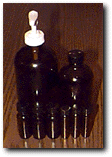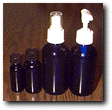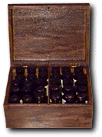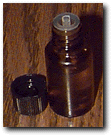Storing Essential Oils
Why Does Essential Oil Storage Matter?
Proper essential oil storage can drastically protect and prolong the shelf life of your oils. The type of glass your oils are stored in, the temperature they are stored at and the sun beaming down on your essential oil bottles can all impact their quality.
This article focuses primarily upon storing essential oils to maximumize their shelf life, but it is also important that you remember that essential oils should be stored so that they cannot be accessed by children or those who may not understand how to use them safely. Essential oils are flammable, so careful storage away from heat and fire sources is also important.
How to Store Essential Oils to Maximize Their Shelf Life

For individual use, essential oils, absolutes and CO2s are most often sold in 5ml, 10ml and 15ml (1/2 ounce) sizes. For more expensive oils, it is common to find them available in sizes starting at 2ml and 1 dram sizes. (Visit the Measurements page for more information on understanding the measurements used in aromatherapy.)
Although essential oils do not become rancid, they do oxidize, deteriorate and lose their beneficial therapeutic properties over time. Oils such as the citrus oils will oxidize and begin to lose their aroma and therapeutic properties in as little as six months. Not all essential oils diminish in aromatic quality as time passes. The aroma of essential oils such as patchouli and sandalwood mature with age, however, Robert Tisserand explains that all essential oils oxidize and are subject to losing their therapeutic value in time.1 All essential oils benefit from proper storage and handling.
To avoid deterioration and protect the aromatic and therapeutic properties of your essential oils, store them in amber or cobalt blue bottles. Dark glass such as amber or cobalt helps to keep out deteriorating sunlight. It is best not to store essential oils in clear glass bottles. Clear glass bottles are not harmful to essential oils, but clear glass does not protect the oils from damaging sunlight. In comparison, you may have noticed that most bottled beer typically is packaged in amber (brown) glass bottles to help protect the contents from exposure to light. Except for certain situations that most often pertain for bulk oil purchases, avoid purchasing or storing pure essential oils in plastic bottles as the essential oil will eat at the plastic, and the essential oil will become ruined over a short period of time. Some vendors sell oils in lined aluminum bottles. It has been said that aluminum bottles are acceptable if the interior of the bottles are lined.
Essential oils should also be stored in a cool, dark place.

Glass amber "Boston round" bottles that essential oils are typically stored in. Other liquids used in aromatherapy (hydrosols, carrier oils, etc.) are also frequently stored in amber bottles.

Glass cobalt blue "Boston round" bottles that essential oils are sometimes stored in. Cobalt blue bottles are usually a little more expensive than amber colored bottles.

Wooden box used to store essential oils. Suitable boxes can be economically purchased unfinished from many craft stores and finished to suit the individual's taste.
Avoid purchasing essential oils that are stored in bottles that have a rubber dropper incorporated into its screw-top cap. Droppers with rubber bulbs should not be kept with the essential oil bottle as the highly concentrated oil can turn the rubber bulb into gum and ruin the essential oil.
Instead of a rubber dropper top, many essential oils that are sold to consumers in sizes of 1 ounce (30 ml) and smaller are packaged in bottles that contain an orifice reducer. An orifice reducer is a small, clear insert inside the bottle opening that acts as a built-in dropper. They are also known as euro droppers.K Unlike the material that rubber dropper bulbs are made of, orifice reducers are made of a material that can withstand exposure to essential oils. The name orifice reducer may seem a little strange at first, but it's a handy little dispensing device. You simply tip the bottle and you can dispense the oil drop by drop.
Not all essential oil suppliers provide orifice reducers. This is not necessarily a reflection on the integrity of the company or the quality of their oils. Wholesalers in particular often do not package with orifice reducers as their primary clientele are artisans and larger natural/holistic formulators that don't dispense essential oils by the drop. If this is important to you, it's best to ask vendors what type of packaging they use when bottling their oils.

1/2 ounce (15 ml) size bottle with an orifice reducer.
Store Your Essential Oils in a Cool Location or the Refrigerator
Prominent aromatherapy expert Robert Tisserand advocates storing essential oils in a refrigerated environment, whenever possible.2 If that is not possible, store them in as cool a location as possible.
References and For More Helpful Information...
1"Lemon On The Rocks: Keep Your Essential Oils Cool" (Robert Tisserand, 2013) [Web site].
2"Ibid.